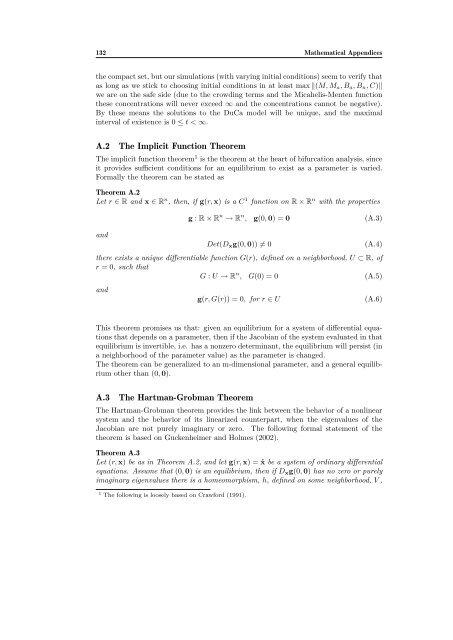nr. 477 - 2011 - Institut for Natur, Systemer og Modeller (NSM)
nr. 477 - 2011 - Institut for Natur, Systemer og Modeller (NSM)
nr. 477 - 2011 - Institut for Natur, Systemer og Modeller (NSM)
You also want an ePaper? Increase the reach of your titles
YUMPU automatically turns print PDFs into web optimized ePapers that Google loves.
132 Mathematical Appendices<br />
the compact set, but our simulations (with varying initial conditions) seem to verify that<br />
as long as we stick to choosing initial conditions in at least max (M, Ma, Ba, Bn, C)<br />
we are on the safe side (due to the crowding terms and the Micahelis-Menten function<br />
these concentrations will never exceed ∞ and the concentrations cannot be negative).<br />
By these means the solutions to the DuCa model will be unique, and the maximal<br />
interval of existence is 0 ≤ t < ∞.<br />
A.2 The Implicit Function Theorem<br />
The implicit function theorem 1 is the theorem at the heart of bifurcation analysis, since<br />
it provides sufficient conditions <strong>for</strong> an equilibrium to exist as a parameter is varied.<br />
Formally the theorem can be stated as<br />
Theorem A.2<br />
Let r ∈ R and x ∈ R n , then, if g(r, x) is a C 1 function on R × R n with the properties<br />
and<br />
g : R × R n → R n , g(0, 0) = 0 (A.3)<br />
Det(Dxg(0, 0)) = 0 (A.4)<br />
there exists a unique differentiable function G(r), defined on a neighborhood, U ⊂ R, of<br />
r = 0, such that<br />
G : U → R n , G(0) = 0 (A.5)<br />
and<br />
g(r, G(r)) = 0, <strong>for</strong> r ∈ U (A.6)<br />
This theorem promises us that: given an equilibrium <strong>for</strong> a system of differential equations<br />
that depends on a parameter, then if the Jacobian of the system evaluated in that<br />
equilibrium is invertible, i.e. has a nonzero determinant, the equilibrium will persist (in<br />
a neighborhood of the parameter value) as the parameter is changed.<br />
The theorem can be generalized to an m-dimensional parameter, and a general equilibrium<br />
other than (0, 0).<br />
A.3 The Hartman-Grobman Theorem<br />
The Hartman-Grobman theorem provides the link between the behavior of a nonlinear<br />
system and the behavior of its linearized counterpart, when the eigenvalues of the<br />
Jacobian are not purely imaginary or zero. The following <strong>for</strong>mal statement of the<br />
theorem is based on Guckenheimer and Holmes (2002).<br />
Theorem A.3<br />
Let (r, x) be as in Theorem A.2, and let g(r, x) = ˙x be a system of ordinary differential<br />
equations. Assume that (0, 0) is an equilibrium, then if Dxg(0, 0) has no zero or purely<br />
imaginary eigenvalues there is a homeomorphism, h, defined on some neighborhood, V ,<br />
1 The following is loosely based on Craw<strong>for</strong>d (1991).
















